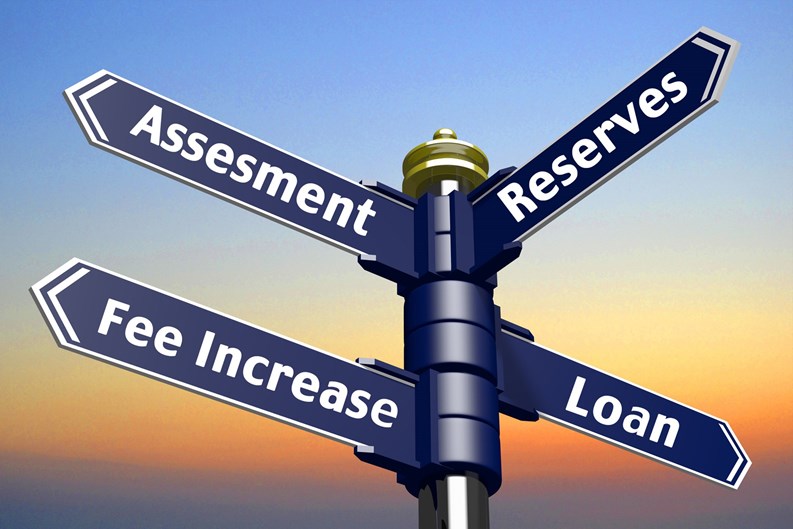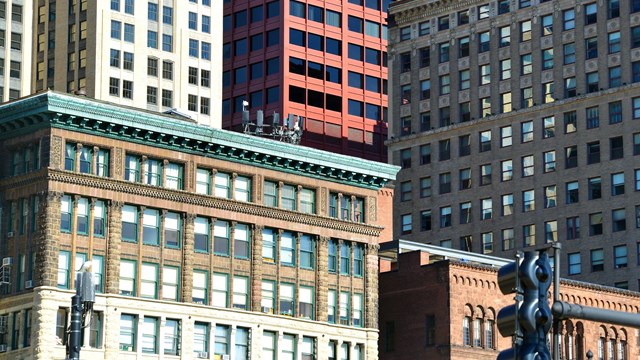You work hard and try to put money away to be used for a rainy day – hoping, of course, that that ‘rainy day’ is a long-awaited trip to somewhere fabulous and tropical. Then, boom – the brakes on your car suddenly go, or one of the kids needs braces, and now you’re tapping into your reserves to pay for these surprise expenses. Sometimes, though, you may not have enough dough to cover the costs, so you have to borrow from friends or family or even take out a loan with your local bank.
Even for a financially solvent community, a major repair or replacement project – such as a new roof, a total window replacement, or a similar big job – can trigger the same kinds of stress we feel regarding our own finances. There is the same concern about whether or not the board has put enough money aside to actually cover an emergency repair or capital improvement project. And if they haven’t, what then? How do you raise the money to get the roof get replaced or the clubhouse made whole after an uninsured mishap?
A Capital Idea
“Capital improvement projects fall under some pretty wide descriptions of anything that could go on at a property, from alterations and improvements to the common areas and replacement of mechanical systems, to concrete restoration, clubhouse upgrades, and even a new structure or amenity,” said Andrew Lester, president of FirstService Financial, a lender active in markets across the country.
A capital project is something that happens about every 10 or 15 years, so the board should definitely be planning to fund those repairs over time – indeed, it’s part of their fiduciary duty to the building and its residents. “Many buildings have what’s called a reserve study so that they can determine when things are going to need to be replaced and how much they need to put away over time to be able to handle those repairs when they come up,” says Lauren Peddinghaus, owner of Haus Financial Services LLC in Chicago. “However, we find that a lot of buildings have failed to plan for reserves, and no money has been saved.”
Peddinghaus says that an empty or inadequate reserve comes down to a lack of planning, and a hesitance to make that investment into the future of the building. “The owners who live there now don’t want to think about what’s going to happen 15 years down the road when they may not be an owner,” said Peddinghaus. “But it’s their responsibility while they’re using those elements to be contributing to the eventual replacement of those elements and not for that to fall on the new people who come in. Then there’s a 10-year-old roof, and there has been no money saved, and now the current residents get hit with having to contribute to get that replaced.”
Even if a building has done its due diligence and planned for future repairs and replacements, how much they saved may not always be enough. “You can only plan to hit the mark, but [sometimes] things happen, whether it’s a capital improvement costing more than you thought it would, or it’s a bigger project than you staked out,” says Lester.
Three Options
To pay for such projects as a new roof, repairing leaky windows or broken steps, a co-op, condominium or homeowners association has three sources of funding to turn to, Lester continues. “The first is using reserve funds that are set forth on an annual basis through the budget,” he advises.
While consumers are often advised to keep a minimum of six months of expenses in a savings account, how much a board should keep on hand depends on who you listen to. “It should be commensurate with the general price or value of the assets. For example, according to Kurt M. Westfield, director of WC Equity Group based in Tampa, Florida, “An investment group that purchases a 64-unit apartment building for just over $6 million should have well more than $40,000 in cash on hand, unless a private round of fund-raising is underway.”
The community’s membership then pays into that reserve fund on an ongoing basis. “The general rule of thumb is to maintain an operating reserve fund of two to three months of common charges for condos and maintenance for co-ops,” says Barry P. Korn, CFA, managing director of Barrett Capital Corporation in New York City.
The amount of the reserve fund is also determined by the size and the budget of the HOA. “The Federal National Mortgage Association (FNMA), commonly known as Fannie Mae, has suggested that HOAs allocate 10 percent of their annual budget to a reserve fund,” says Korn. “This is a good estimate, which can vary based on what the building anticipates, particularly if they have done a reserve study of the useful lives of the building’s major system components. As a building builds up its capital reserve funds, it can tap into this to pay for some capital items.”
However, Korn says that it is not recommended for a board wipe out their entire reserve fund for any one project. If this looks like that may happen, Korn says that the board should look into other financial resources, such as a loan or a special assessment, to cover the balance.
Loans and Assessments
To borrow money for any capital repair or improvement project, a board will go to a financial institution and negotiate rates and terms for the funds that they need and then pay it back over time. “Generally, the payment of that loan comes from either reserves or a special assessment,” says Lester.
But loans can be risky in and of themselves, cautions Westfield. “I would still object that this level of liquidity is dangerous to the ownership and the management of the asset. An alternative option is a refinance with a commercial/conventional/private lender to pull liquidity out to cover the cost of improvements.”
If a board of directors and the membership decide that they want to move forward with a project, but they do not have enough funds in their reserves or from investments, and a bank loan isn’t palatable, they can pass a special assessment. “They collect that money [from residents] over a period of time or in a one-shot payment,” says Lester.
Reserves, loans and assessments, oh my! How does a board make a final decision on how to fund a major project? “First, a board should get competitive bids so as to determine a realistic cost for the project,” says Korn. “A board should make sure that its ‘soft’ costs, such as designer, architect and engineer fees are included, and a board should build a cushion of, say, 10 to 20 percent into the total project cost.”
Then, it’s up to the board of directors to decide what money will be used to pay for this project. “It depends on the association, the community and where they are, and their documents, and the size of the project,” says Lester. “The membership might have a vote or a say in the matter, but in general terms, the board of directors makes the final decision and then goes to membership for approval.”
To make an informed decision on a capital project, a board should have a team of experts to turn to. “The board, with the help of architects and engineers, should determine the approximate cost of the project to be funded, then the board or treasurer should reach out to financial advisors/mortgage brokers specializing in HOA loans to have the broker review the financials of the HOA, including existing debt and accounts in arrears,” says Korn. “After the broker determines the existing debt service and increase from the new loan, the board should review the impact of an increase in maintenance/common charges on the owners.”
An attorney can also help the board to understand the financial documents. “Then, obviously, they help with the closing of the loan with buyers,” says Lester.
Tricky situation
Unfortunately, a building with no reserves for capital improvement projects or emergency repairs is becoming all too familiar. “Clearly, the board is at fault,” says Peddinghaus, “but it is feasible to obtain a loan with no reserves, with the understanding that part of the proceeds are dedicated to go into and build the reserve funds to a level at which the bank is comfortable.”
Peddinghaus also reminds the residents that the board has a fiduciary duty to the entire association to do what’s in their best interest. “Everything comes down to who those people are,” she says. “I’ve seen associations where the owners aren’t going to have any problems coming up with money when it’s needed, and [the association] doesn’t put anything in the bank. They just do a special assessment whenever they need more money.”
If the residents aren’t happy with how the finances are being handled, there is a solution. “If owners aren’t happy with the way their board is financially managing the building, then they need to put a new board in place,” said Peddinghaus. “That’s the remedy. If you’re unhappy, then replace them.”
Lisa Iannucci is a freelance writer, editor, and author, and a frequent contributor to The Chicagoland Cooperator.










Comments
Leave a Comment